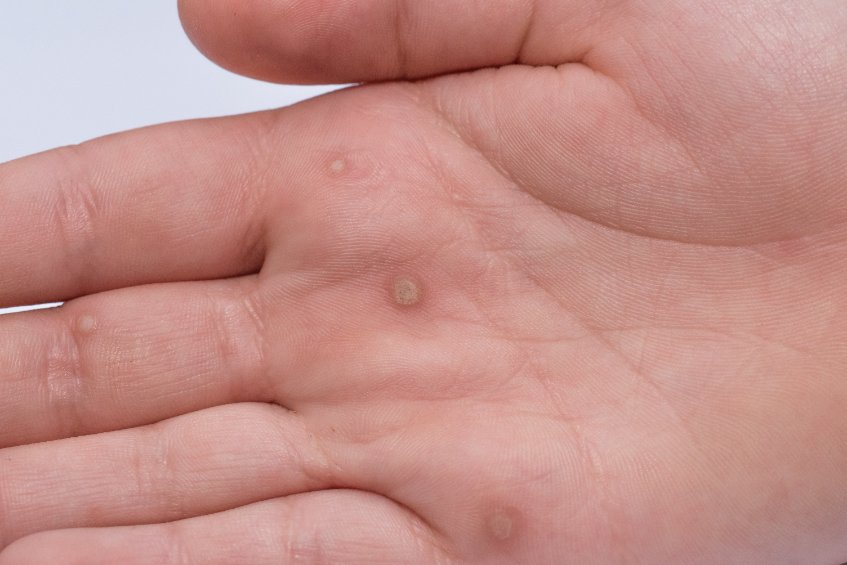SHARUM SHARIF, ND
My primary care naturopathic practice has a focus on natural dermatology. I utilize a variety of naturopathic therapeutics to address skin diseases of all types, including warts, but my primary tool is homeopathy. I have successfully treated a few hundred patients with warts over the last nearly 2 decades, and I would like to share my findings with colleagues here to contribute to a world free from warts.
When properly selected, homeopathic remedies are nearly always completely curative with long-lasting effects. In my practice, I have only seen a single patient whose warts returned after successful eradication of all of his warts with homeopathic treatment.
The Skin, Where Internal Diseases Manifest
The skin is our largest eliminative organ. When the ability of the kidneys, liver, intestines, and lungs to clear toxins from the body is overrun, the skin often will help out more. Therefore, when something appears on the skin, it is usually a sign of a toxic state or imbalance inside the person. Skin signs and symptoms can be an early sign of many other potentially serious conditions. These can include various types of cancer – and not just skin cancer. At other times, skin conditions are the end result of chronic systemic weaknesses or illnesses.
Homeopathic practitioners often view skin conditions as representations of diseases occurring within the body itself. The classical homeopath J. Compton Burnett, MD, states: “If disease of the body bubbles up, so to speak, into the skin like water from a spring, to treat this disease in (of) the skin by washes and ointments, or other outward applications, is really not treating the diseased state at all, but only preventing its peripheral expression.”1 In other words, using topical treatments does little more than palliate symptoms; at worst, it suppresses the body’s natural tendency to push disease away from its core. The conventional dermatologists and homeopaths Ramji Gupta, MD, and R.K. Manchanda, MD, view topical treatments with a more sympathetic eye, giving them a more central place in patient treatment. They state, “Most of the diseases in Homeopathy are treated with internal medicines alone. However, non-medicated emollients, powders, etc, are sometimes used for giving symptomatic relief to the patients.”2
Warts: A Background
Warts are a common, nearly universal skin conditions. They are caused by the human papillomavirus, of which there are over 150 types. Although they are not tremendously contagious, they are transmitted through contact, especially where abrasions or scratches occur. They can also be self-transmitted from site to site. It is common to see them on elbows, knees, hands, around fingernails, and especially the feet, where they are known as plantar warts.3 Usually, warts are flesh-colored and rough to the touch, but can also have a color other than the skin and be smooth. They are usually painless, benign growths, and the incubation period of a wart is very long – after initial contact, it may take a few weeks to many months to appear. The risk of catching warts from another person is extremely minimal. Warts often regress on their own in children, but can be chronic in adults, especially in immunocompromised individuals.
In conventional dermatology, there are 5 different types of warts. Common warts resemble papules with a classic wartlike, or verrucous, surface. Plane warts also resemble papules but have a flatter top. Filiform warts simply have an irregular surface. The remainder are based on location: plantar warts are found on the foot, while genital warts, also known as condyloma acuminata, are obviously found around the genitalia. The appearance of a wart quite often depends on the site where it is growing.
Although diagnosing warts is usually straightforward because of their universal nature, there are a number of differential diagnoses that should be considered – some rather serious. Corns or calluses are among the simplest of conditions to consider, mainly caused by friction rather than viruses. Molluscum contagiosum, another differential, is viral in origin. Gawkrodger recommends considering amelanotic malignant melanoma, periungual fibroma, and bony subungual exostosis when faced with viral warts under the fingernails or toenails.4 It is also important to rule out squamous cell carcinoma on persistent, nonresolving warts on the hand, foot, or around nails.
Other serious conditions to consider, particularly with genital warts, include vulval, penile, and anal intraepithelial neoplasias, which can resemble viral warts or seborrheic keratosis. Condylomata lata, a manifestation of secondary syphilis, can resemble anogenital warts as well. Finally, HPV infections in organ transplant patients have been linked with skin cancers.4
Warts that are painful, that bleed frequently, or that multiply rapidly should be treated. Many patients also seek treatment for warts mainly due to their unsightly appearance and sometimes out of fear of spread. But considering how benign warts usually are, conventional treatments are often difficult, sometimes painful, and can even border on barbaric. Salicylic acid may be used in repeated applications to treat warts. Similarly, liquid nitrogen may be used to freeze the wart. Unfortunately, both treatments have been shown to have a success rate of less than 50%,5,6 and liquid nitrogen in particular is associated with significant discomfort both during and after the procedure. Other treatments include burning the wart with an electric needle or a laser. Warts may be cut out surgically, or injected with an antiviral medication or even an antigen meant to stimulate the immune system to destroy the virus causing the wart. Results vary, treatments may result in scarring, and at worst, new warts may appear.7 In the face of such treatments, it is worth considering homeopathy as a viable, pain-free, and often successful alternative to addressing warts.
Repertorization of Warts
There are a large variety of warts discussed in homeopathic repertories. For different types of warts depending on their specific characteristics, a great place to start is the rubric Skin-Warts. Also bear in mind that in early homeopathic repertories, warts were classically referred to as excrescences or verrucas – so consider searching under these terms when “warts” does not seem to produce desired rubrics. The Synthesis Homeopathic Repertory lists some particularly interesting rubrics; these include descriptions like drawing, lupoid, pulsating, cylindrical, stinging, and cold.8 Some rubrics even describe opposing characteristics of warts: dry/moist, small/large, flat and smooth/jagged, and soft/hard.
Locations are another important consideration for wart rubrics. For warts in the extremities, refer to the appropriate section. A partciularly useful rubric for children’s finger warts may be found in the extremities chapter: Extremities-Warts-Fingers-Nails-Close to. In general, refer to the appropriate location in the repertory; nose, face, chest, and extremities are all common places.
The depth of detail in homeopathic literature for addressing various types of warts based on their location, appearance and sensation can be overwhelming. For instance, Samuel Lilienthal, MD, lists 6 various remedies for warts on the face in general, then lists 6 more rubrics based on different facial locations. These include places as specific as eyelids, under the eyes, at the angles of the mouth, and even on the tongue.9
Genital warts merits its own repertorization discussion. You may start with the rubric Skin-Excrescences: Condylomata. Also consider looking for genital wart rubrics in both the male and female sections, under Male-Condylomata or Female-Condylomata. They may also be found under Skin-Excrescences-Condylomata. Other sections include: Eye/Mouth/Throat/Rectum-Condylomata.
Obviously, some remedies will show up in multiple wart rubrics. For example, Staphysagria is listed under rubrics for cauliflower warts, pedunculated warts, and warts that are sensitive to touch. But sometimes, looking at a fulller constitutional picture can help the practitioner select the ideal prescription. For example, if the wart is cauliflower-shaped, sensitive, and is located in the genital area of a hypersexual and highly prideful patient, Staphysagria would be an even stronger possibility, since not just the wart description but indeed the rest of the patient’s constitutional appearance matches the remedy well.
Sometimes, the same remedy may appear in opposite rubrics. For example, Dulcamara and Sepia appear in rubrics for both small and large warts. Similarly, Antimonium crudum appear in rubrics for soft and hard warts. This can, of course, be baffling. But don’t let this confuse you. Look at other particulars of the wart, and pay attention to other aspects of the case. Let those point you to the most indicated remedy.
You may also consult different repertories and materia medica to refine your repertorization. But this can sometimes make acute prescribing for warts even more complicated; different authors usually have similar but sometimes different remedies for different types of warts and discuss different indications for even the same remedy. For example, in his book A Handbook of Skin Diseases, and Their Homeopathic Treatment, John Kippax, MD, points out that Lycopodium is indicated for pedunculated warts.10 However, in Homeopathic Therapeutics, Dr Lilienthal explains that Lycopodium is indicated not only for pedunculated warts, but also warts that are split and furrowed, warts surrounded by a herpetic areola, and warts with bran-like desquamation.9
Prescription and Treatment
The principal methods of prescribing in homeopathy are acute and constitutional. To find an acute remedy for a patient, we need to search for characteristic (specific and unique) symptoms of the individual’s disease; we then find a remedy whose characteristic (keynote) symptoms match the patient’s characteristic symptoms. Keep in mind that an acute remedy addresses only a few of the patient’s (characteristic) symptoms. In contrast, a constitutional (or chronic) remedy is based on a person’s mental, emotional, and physical signs and symptoms.
To treat warts, you need to figure out if the warts are part of a local disease or are due to a constitutional matter. If a patient’s warts have very unique characteristics or are not responding to a well-indicated constitutional remedy, consider an acute prescription. Otherwise, I’d recommend constitutional prescribing for the treatment of warts. Ideally, the remedy you choose would not only match the characteristic symptoms of the patient’s warts (acute symptoms), but also cover constitutional characteristic symptoms head to toe. The benefit of using a well-indicated constitutional prescription is that not only do the warts gradually disappear without any local damage to the tissues but the patient is left feeling better in the physical, mental, and emotional planes. Regardless of whether you choose to prescribe based on an acute picture or a constitutional picture, explore what is most unique and striking about the patient’s warts – the location or the charateristic clinical presentation of the wart.
Finally, it is best to use low potencies and repeated doses to treat most skin conditions, including warts. I usually start with daily dosing of potencies such as 6C or 12C. I expect positive changes within 1-2 months. However, if your patient has numerous warts, total eradication may take several months. The prudent practitioner should encourage patience with their patients when treating warts, and not jump to a different remedy too soon.
I once had a patient with numeorus warts on the dorsum of both hands that would bleed easily. According to Kippax, Bufo is the main remedy for wart on the back of the hands.10 Though it might have been tempting to prescribe Bufo based on this rubric, I saw that it did not match any other aspects of my patient’s case, so I did not prescribe it. According to Gupta and Manchanda, Dulcamara was also a remedy to consider: “useful for warts which are large, smooth, painless, present on face and hands, esp the dorsal surface.”2 However, this patient’s warts were not large and painless, so Dulcamara was not indicated for her either. What was striking and unique about her warts was that they would often bleed readily. Since I was not aware of the bleeding aspect of this patient’s warts, it took several visits for me to finally figure out the indicated remedy in her case – Nitricum acidum, an excellent remedy for bleeding warts. My patient’s numerous warts completely disappeared within several weeks of using the remedy, and they have not returned for a few years now.
Thuja and Sulphur: Panaceas for Warts?
Thuja shows up often in homeopathic literature for warts. Even non-homeopaths familiar with natural medicine seem to know about the use of homeopathic Thuja for the treatment of warts of various types. As mentioned above, it’s particularly helpful for genital warts, particularly those that resemble a cauliflower. But even though Thuja shows up in a number of wart-related rubrics in homeopathic repertories, it is not in all of them. So Thuja is not a panacea for warts – even genital warts. There are many other well-indicated and effective remedies for the treatment of warts. (However, topical Thuja oil, while not homeopathic per se, is a simple idea for eliminating all sorts of warts.) Other remedies to consider for genital warts include Sabina, Cinnabaris, and Staphysagria.
Sulphur, like Thuja, appears in many wart rubrics in a homeopathic repertory. And also like Thuja, Sulphur is not a panacea for warts either. Miasmatically speaking, the main difference between these remedies is that Thuja is a sycotic remedy while Sulphur is a psoric one. Unfortunately, the subject of miasms is beyond the scope of this article. Just remember you need to look at the whole person in order to decide on the most effective remedy.
Other Remedies for Warts & Their Characteristics
Since practitioners consider Thuja so readily when treating warts, it is worth knowing the appearance of warts that will likely respond to this remedy. According to Morrison, warts that may respond well to Thuja have particular characteristics beyond the cauliflower-like, pedunculated picture we associate with genital warts, as mentioned above. They may appear as “broad-based, conical shaped warts” or “indented warts.” They may look red, brown, or otherwise dark. Older warts may be “cracked and oozing,” and may have “an odor of old cheese.” And beyond appearing in or around the genitalia, Thuja warts may appear on the face, the lips, the nose, the hands, or the feet.11
Other remedies that are commonly used for warts will likely be effective based in large part on their presentation. Consider these appearances of warts and the remedies that may effectively treat them:
- Causticum is for “old warts on nose and eyebrows, on face, nail and fleshy tips of fingers.”9
- Antimonium crudum is for “horny warts over palms and soles which are very painful.”2
- Dulcamara is “useful for warts which are large, smooth, painless, present on face and hands, esp the dorsal surface.”2
- Nitric acid is indicated for “warts which are large, jagged, bleed easily on washing and have stinging pain.”2 They also “look like Thuja, but they are bleeding and very sensitive to touch.”12
- Staphysagria is for dry, very sensitive, painful to touch, pedunculated, or cauliflower-like warts on genitals.12
A Wart-Free Existence
Warts are universal, as widely varied as the 150 types of human papillomavirus that give rise to them, and as individual as each patient that presents with them. Treatments seem to be nearly as diverse, too, and many of them can be disturbingly painful and barbaric. Homeopathy has long offered a pain-free and effective means of treatment that depends on the skill, patience, and research of the practitioner. I would like to share my experience with my fellow colleagues so their patients may have wart-free skin – without the unnecessary troubles that come with so many other therapies.
[REFS]
- Burnett JC. Diseases of the Skin: Their Constitutional Nature and Cure. New Delhi, India: B. Jain; 1997.
- Gupta R, Manchanda RK. Textbook of Dermatology for Homeopaths. Noida, Uttar Pradesh, India: B. Jain Publishers (P) Ltd.; 2019.
- Habif TP. Skin Disease: Diagnosis and Treatment. Philadelphia, PA: Elsevier Mosby; 2005.
- Gawkrodger DJ. Dermatology an Illustrated Colour Text. Edinburgh, UK: Churchill Livingstone; 2003.
- Bruggink SC, Gussekloo J, Berger MY, et al. Cryotherapy with liquid nitrogen versus topical salicylic acid application for cutaneous warts in primary care: randomized controlled trial. CMAJ. 2010;182(15):1624-1630.
- García-Oreja S, Álvaro-Afonso FJ, García-Álvarez Y, et al. Topical treatment for plantar warts: A systematic review [published correction appears in Dermatol Ther. 2021 Mar;34(2):e14941]. Dermatol Ther. 2021;34(1):e14621.
- Signore RJ. Warts and All! The Homeopathic Approach to Treating People With Warts. Homeopathy Today. 2015:16-21.
- Schroyens F, Vithoulkas G. Synthesis: Repertorium Homeopathicum Syntheticum. London, UK: Homeopathic Book Publishers; 1993.
- Lilienthal S. Homoeopathic Therapeutics. New Delhi, India: B. Jain; 1986.
- Kippax JR. A Hand-Book of Diseases of the Skin and Their Homeopathic Treatment. New Delhi, India: B. Jain Publishers (P) Ltd.; 2006.
- Morrison R. Desktop Companion to Physical Pathology. Nevada City, CA: Hahnemann Clinic Publ.; 1998.
- Murphy R. Skin Disorders. Audio CD series. Lotus Health Institute: 2007.

Sharum Sharif, ND, is a 2003 graduate of Bastyr University. He has a primary care practice in Kent, WA, and is an affiliate clinical faculty at Bastyr University. He maintains the website www.HomeopathicDermatology.com with numerous patient testimonials for warts and other skin conditions You can also find his AANP talk as well as an NDNR article on the subject of Homeopathic Dermatology on the same page. Dr Sharif has also presented at numerous naturopathic conventions and is the author of the textbook Visual Homeopathy.





